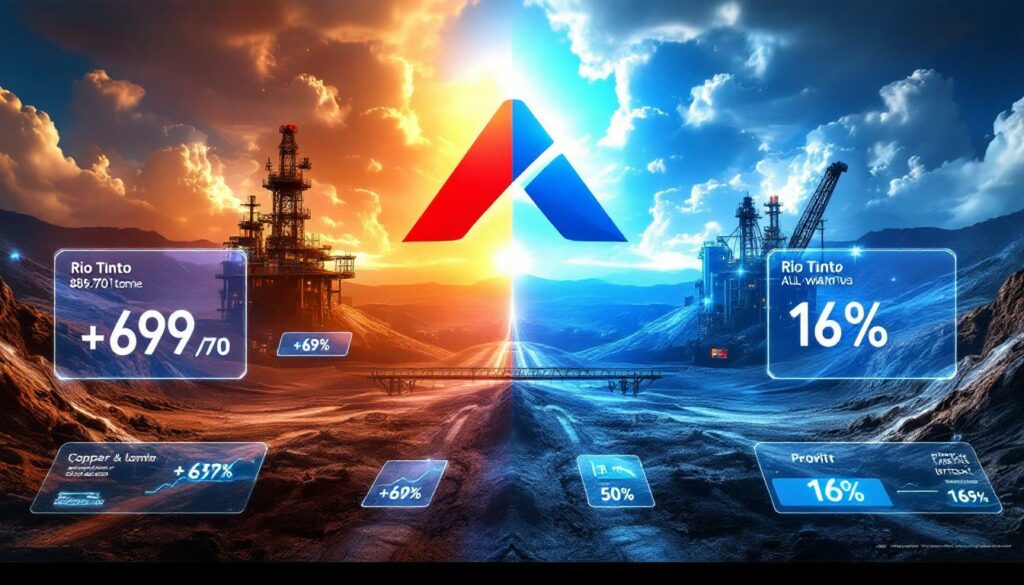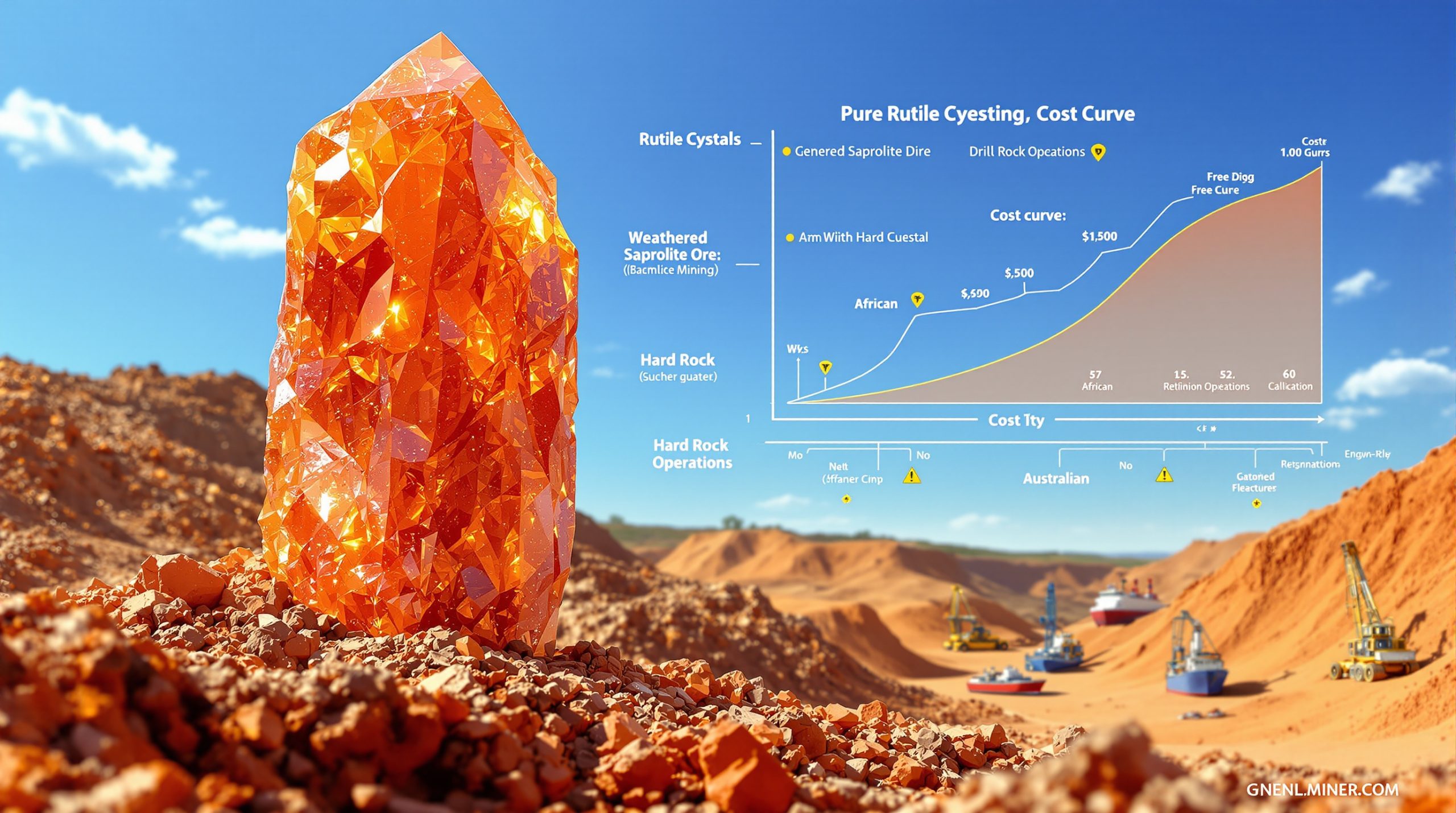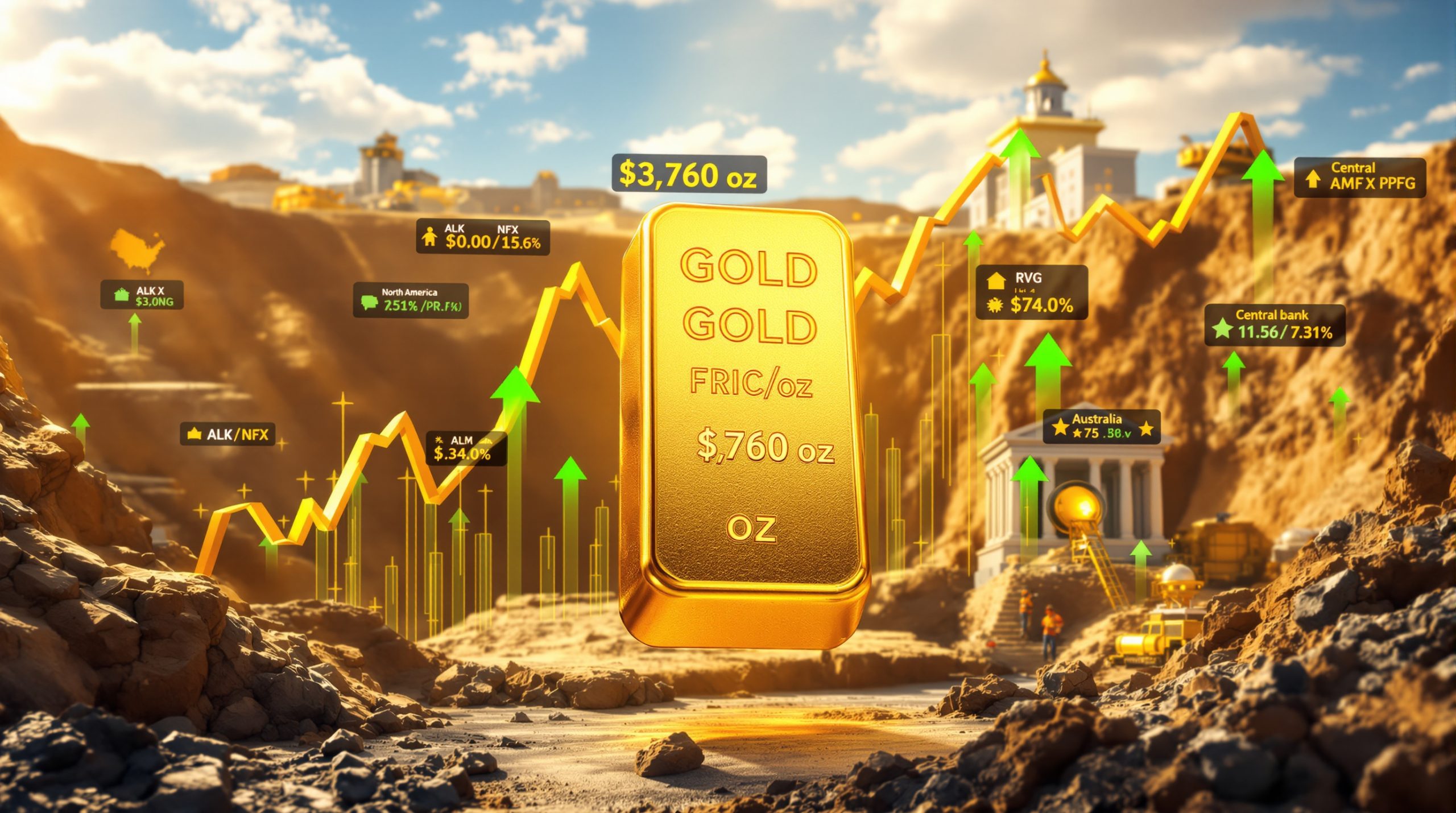Rio Tinto Shares Slip on Soft Interim Results: Market Impact Analysis
Rio Tinto's recent interim financial results have sent ripples through the mining sector, with the company's shares experiencing a notable decline despite resilience in key segments. This comprehensive analysis examines the factors behind the share price movement, operational challenges, and what these results signal for both the company and investors in the current market landscape.
What Caused Rio Tinto Shares to Drop?
Rio Tinto's shares fell by 1.6% to 4,572.5p in London trading following the release of its interim financial results on July 30, 2025. This decline came as the mining giant reported its weakest first-half profit in five years, with underlying earnings of $4.81 billion representing a 16% decrease compared to the same period in 2024.
The market reaction reflected investor concerns about the sustainability of profits in a challenging commodity price environment, particularly for iron ore which remains Rio Tinto's primary revenue driver.
Despite the decline, CEO Jakob Stausholm characterized the results as "very resilient" given the headwinds from weaker metal prices. This measured response suggests management anticipated the challenges but sought to emphasize the company's fundamental strength despite the short-term pressures.
Market Context
The broader mining sector has been experiencing volatility throughout 2025, with commodity price fluctuations creating uncertainty for major producers. Rio Tinto's results reflect this broader industry trend rather than company-specific operational failures.
Analyst expectations had generally anticipated a profit decline, though the 16% drop was at the steeper end of consensus forecasts, explaining part of the negative market reaction.
How Did Iron Ore Prices Affect Rio Tinto's Performance?
The primary factor behind Rio Tinto's softer results was the significant decline in iron ore price trends, which fell by 15% to an average of $89.70 per dry metric tonne during the reporting period. This compares to an average of approximately $105.50 per dry metric tonne in the first half of 2024.
This price decrease stemmed from several market factors converging simultaneously:
- Weakening global demand for steel production, particularly in China
- Increased global iron ore supply creating downward price pressure
- Higher production costs in the Pilbara region
- Operational disruptions from cyclone recovery efforts
The company noted that Pilbara unit cash costs rose to $24.30 per wet metric tonne, up from approximately $21.80 in the previous year. This cost increase was specifically "impacted by lower volumes and cyclone recovery costs," creating a dual squeeze on profitability from both lower selling prices and higher production costs.
Geological and Operational Challenges
Beyond the headline figures, Rio Tinto faced significant operational challenges in its iron ore business. The cyclone recovery mentioned in the results refers to disruptions from seasonal weather patterns in Western Australia that affected mining operations, rail transportation, and port facilities.
These weather events have become increasingly unpredictable in recent years, requiring mining companies to build additional operational flexibility and contingency planning into their production schedules.
Which Business Segments Performed Well Despite Challenges?
Despite the challenges in iron ore, Rio Tinto demonstrated the value of its diversified portfolio with strong performances in other key segments:
- Copper division: Earnings surged 69% to $3.10 billion (compared to $1.83 billion in H1 2024)
- Aluminum operations: Earnings increased 50% to $2.40 billion (compared to $1.60 billion in H1 2024)
These impressive gains in non-iron ore segments helped offset the decline in the company's traditional core business, highlighting the strategic importance of maintaining a balanced commodity portfolio in the mining sector.
Copper Performance Drivers
The exceptional performance in copper came during a period of strong global copper prices, driven by:
- Increasing demand from electric vehicle manufacturing
- Renewable energy infrastructure expansion
- Limited new supply coming online from major global mines
- Declining ore grades at existing operations
Rio Tinto's copper operations, including the Kennecott mine in Utah, Oyu Tolgoi in Mongolia, and interests in Escondida in Chile, benefited from these favorable market conditions while also achieving operational improvements. Recent copper market insights have further highlighted the metal's growing importance in the global economy.
Aluminum Market Dynamics
The 50% increase in aluminum earnings reflects both improved market conditions and operational efficiency gains. Key factors included:
- Higher global aluminum prices
- Increased premiums for low-carbon aluminum products
- Energy cost advantages at Rio Tinto's hydropower-supplied smelters
- Ongoing productivity improvements across the aluminum division
This segment's performance demonstrates how Rio Tinto's vertical integration in the aluminum value chain—from bauxite mining to alumina refining to aluminum smelting—provides resilience against market volatility.
What Is Rio Tinto's Financial Position After These Results?
Despite the profit decline, Rio Tinto maintained strong financial fundamentals:
- Generated $6.92 billion in net operating cash flow
- Produced $1.96 billion in free cash flow (down 31% from $2.84 billion in H1 2024)
- Committed to $2.4 billion in shareholder dividends
- Maintained "strong balance sheet" according to management statements
The reduction in free cash flow primarily reflected the combination of higher capital expenditure and lower iron ore prices, rather than fundamental operational issues.
Balance Sheet Strength
Rio Tinto's balance sheet remains among the strongest in the global mining sector, with:
- Low net debt levels relative to earnings
- Strong liquidity position
- Investment-grade credit ratings
- Flexible capital allocation framework
This financial strength provides Rio Tinto with significant strategic optionality to pursue growth opportunities, weather market downturns, and maintain shareholder returns even during challenging periods.
"We continue a disciplined investment in profitable growth while retaining a strong balance sheet," the company stated in its results announcement, emphasizing its commitment to financial prudence despite the challenging market environment.
How Is Rio Tinto Positioning for Future Growth?
CEO Jakob Stausholm emphasized that Rio Tinto remains focused on long-term value creation through several strategic initiatives:
- Maintaining production guidance for Pilbara iron ore at the lower end of the 323-338 million tonne range
- Continuing disciplined investment in growth projects
- Leveraging diversification benefits from copper and aluminum operations
- Focusing on "best-in-class project execution"
- Developing a diverse pipeline of future options
Management expressed confidence that these strategies, combined with anticipated growing demand for their products, will position the company for "strong mid-term production growth."
Strategic Growth Projects
While not providing specific details on all projects, Rio Tinto's growth pipeline includes:
- Simandou Iron Ore Project (Guinea) – One of the world's largest undeveloped high-grade iron ore deposits
- Oyu Tolgoi Underground Expansion (Mongolia) – Transforming this operation into one of the world's largest copper mines
- Jadar Lithium Project (Serbia) – Positioning for growth in battery materials
- Rincon Lithium Project (Argentina) – Further expanding presence in the lithium sector
- Kennecott Underground Expansion (United States) – Extending the life of this historic copper operation
"We are well positioned to generate value from our best-in-class project execution, together with growing demand for our products, now and over the coming decades," Stausholm stated, highlighting the company's confidence in its long-term strategy.
What Does This Mean for Investors?
For investors, Rio Tinto's latest results present a mixed picture that requires careful analysis:
- Short-term challenges: Weaker iron ore prices and higher costs are creating near-term headwinds that may persist into the second half of 2025
- Dividend stability: The company's commitment to maintain its dividend policy provides income security for yield-focused investors
- Portfolio strength: Strong performance in copper and aluminum demonstrates the value of diversification and reduces dependence on iron ore
- Long-term outlook: Management remains confident in medium-term growth prospects despite current challenges
The market reaction, with shares trading down 1.6% following the announcement, suggests investors are taking a cautious approach while weighing these competing factors.
Investment Considerations
Investors considering Rio Tinto should evaluate several key factors:
- Dividend yield: At current share prices, the committed $2.4 billion dividend represents an attractive yield compared to broader market averages
- Commodity price exposure: Future performance remains heavily linked to iron ore prices, despite diversification progress
- Growth execution: The company's ability to deliver on its growth projects will be crucial for long-term valuation
- ESG positioning: Rio Tinto continues to emphasize sustainability and responsible mining practices following previous controversies
Long-term investors may view the current share price weakness as a potential entry point, particularly if they believe in the company's diversification strategy and growth pipeline. As noted by analysts at The Motley Fool, Rio Tinto's dividend cut alongside the profit decline has particularly concerned income-focused investors.
How Does Rio Tinto Compare to Industry Peers?
Within the global mining sector, Rio Tinto's performance reflects broader industry trend rather than company-specific operational failures. The factors behind iron ore decline have affected all major producers, though Rio Tinto's diversification efforts have provided some insulation.
- Major miners facing pressure from softening commodity prices, particularly in iron ore
- Increasing importance of portfolio diversification to reduce reliance on single commodities
- Focus on operational efficiency to control costs in an inflationary environment
- Balancing shareholder returns with capital investment for future growth
The company's ability to maintain dividend commitments despite weaker profits demonstrates financial resilience compared to some industry peers who have reduced shareholder returns during challenging periods.
Competitive Positioning
Rio Tinto maintains several competitive advantages in the global mining landscape:
- Tier-one assets: Ownership of some of the world's lowest-cost, longest-life mining operations
- Vertical integration: Particularly in aluminum, controlling the value chain from bauxite to finished metal
- Geographic diversification: Operations across Australia, North America, South America, Europe, Africa, and Asia
- Product diversification: Growing exposure to future-facing commodities like copper and lithium alongside traditional strengths
- Balance sheet strength: Financial flexibility to pursue opportunities throughout commodity cycles
These factors position Rio Tinto to weather short-term volatility while pursuing long-term strategic objectives.
What Are the Key Metrics from Rio Tinto's Interim Results?
| Metric | H1 2025 | Change vs H1 2024 | Impact |
|---|---|---|---|
| Underlying earnings | $4.81 billion | -16% | Lowest first-half profit in five years |
| Iron ore price (realized) | $89.70 per dry metric tonne | -15% | Major contributor to profit decline |
| Pilbara unit cash costs | $24.30 per wet metric tonne | +11.5% | Margin pressure on core operations |
| Copper earnings | $3.10 billion | +69% | Significant positive contribution |
| Aluminum earnings | $2.40 billion | +50% | Important diversification benefit |
| Net operating cash flow | $6.92 billion | Not specified | Demonstrates continued strong cash generation |
| Free cash flow | $1.96 billion | -31% | Reflects higher capex and lower iron ore prices |
| Planned dividends | $2.4 billion | Maintained | Commitment to shareholder returns |
These metrics provide a comprehensive view of Rio Tinto's performance across key business segments and financial parameters, highlighting both challenges and areas of strength.
FAQ: Rio Tinto's Interim Results
Why did Rio Tinto's profits fall despite strong copper and aluminum performance?
Iron ore remains Rio Tinto's largest revenue and profit contributor, typically accounting for approximately 60-70% of earnings in normal market conditions. Despite impressive growth in copper (69%) and aluminum (50%) earnings, these segments couldn't fully offset the impact of a 15% drop in iron ore prices, which significantly affected the company's overall profitability.
The company's results demonstrate both the benefit of diversification and the ongoing challenge of iron ore dependency. While the portfolio is becoming more balanced, the iron ore business still drives overall financial performance in the short term.
Is Rio Tinto's dividend at risk given the profit decline?
Management has explicitly committed to maintaining its dividend practice, with $2.4 billion in payouts planned despite the profit decline. The company emphasized its focus on "disciplined investment in profitable growth while retaining a strong balance sheet," suggesting dividend stability remains a priority.
Rio Tinto's dividend policy is supported by:
- Strong ongoing cash generation despite profit decline
- Robust balance sheet with low debt levels
- Long-life mining assets with predictable production profiles
- Management commitment to shareholder returns
These factors suggest the dividend remains sustainable unless there is a much more severe or prolonged downturn in commodity prices.
What factors could improve Rio Tinto's performance in the second half of 2025?
Key factors that could positively impact Rio Tinto's second-half results include:
- Recovery in iron ore prices if Chinese steel demand increases
- Continued strong performance in copper and aluminum segments
- Operational improvements and cost control in the Pilbara operations
- Favorable currency movements, particularly AUD/USD exchange rates
- Progress on growth projects that could boost investor confidence
- Reduced impact from weather-related disruptions in key regions
Investors should monitor Chinese economic indicators closely, as they remain the primary driver of iron ore demand and pricing, which in turn significantly impacts Rio Tinto's overall financial performance.
How significant is the diversification into copper and aluminum for Rio Tinto?
The latest results demonstrate the critical importance of Rio Tinto's diversification strategy. With copper earnings up 69% to $3.10 billion and aluminum up 50% to $2.40 billion, these segments provided essential balance against iron ore weakness.
This performance validates the company's long-term strategy of maintaining a diverse commodity portfolio rather than over-concentrating on iron ore. The copper business in particular represents a strategic priority given:
- The metal's essential role in electrification and renewable energy
- Structural supply constraints in global copper production
- Rio Tinto's significant growth opportunities at Oyu Tolgoi and Kennecott
- Higher margins compared to traditional bulk commodities
The diversification strategy provides both short-term resilience during iron ore downturns and long-term positioning for changing global commodity demand patterns. Furthermore, Rio Tinto continues to implement modern mine planning strategies and explore industry innovation trends to maintain competitive advantage.
Disclaimer: This article contains analysis of financial results and mining sector trends. All information is based on published company reports and market data as of July 30, 2025. Future performance may differ substantially from historical results. Investors should conduct their own research and consider seeking professional financial advice before making investment decisions.
Looking to Spot the Next Major ASX Mining Discovery?
Discovery Alert's proprietary Discovery IQ model instantly scans ASX announcements to identify significant mineral discoveries before the broader market catches on, giving subscribers a critical early advantage. Explore historic returns from major discoveries and learn how you could position yourself ahead of the market by visiting our dedicated discoveries page.




